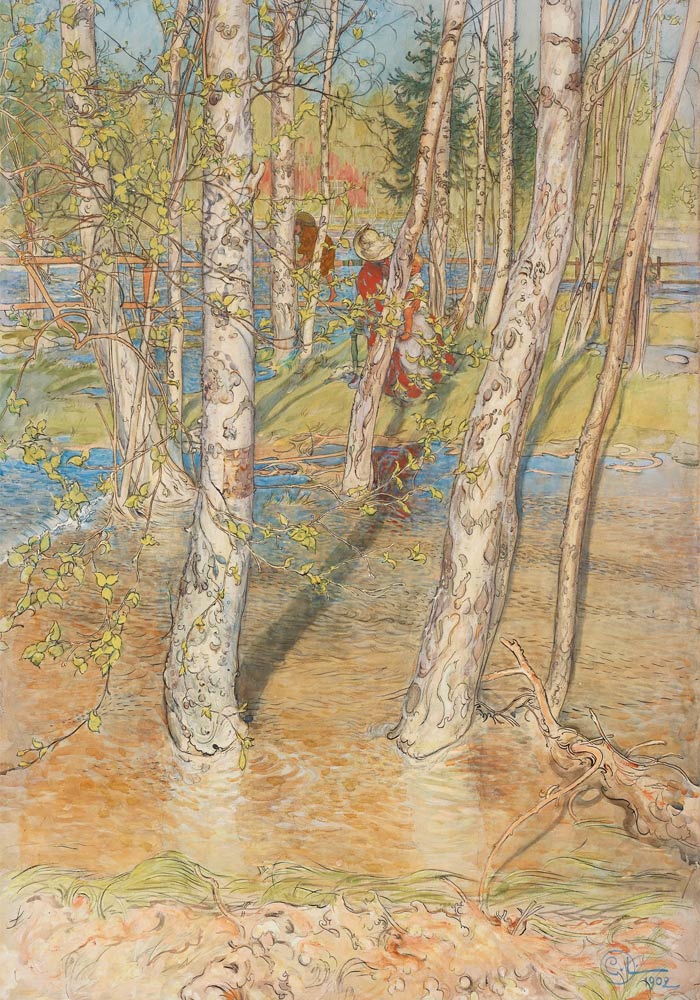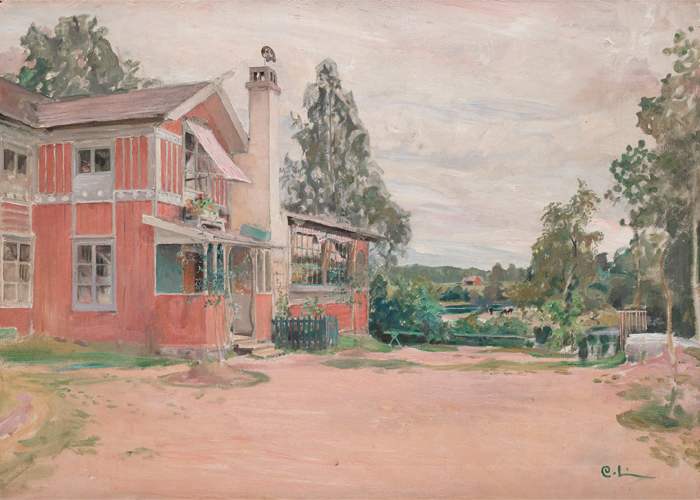Bukowskis Presents Three Important Artworks by Carl Larsson at Important Spring Sale
Carl Larsson, "Vårflod/Översvämning"
In Sundborn, Dalarna, the river floods annually in the spring. In the current painting "Vårflod/Översvämning" from 1902, Carl Larsson captured this phenomenon and framed it around this tender family portrayal. While his wife Karin sits on a chair with Torbjörn on her lap, the daughters run around and explore the floodwaters. The water has created a temporary island where the family can enjoy the warmth of the spring sun.
Family and nature are two recurring themes in Carl Larsson's artistic career, and in "Vårflod/Översvämning" we see him masterfully exploring both. Carl Larsson began in earnest with his family portrayals in 1889 when he moved in with his family to the cottage Lilla Hyttnäs in Sundborn, outside of Falun. Over the next ten years, the family would have residences in Stockholm and Sundborn. In Stockholm, Carl Larsson worked on significant commissioned works, such as the wall paintings for the National Museum, while in Sundborn, he devoted himself to depicting his immediate surroundings and the people around him.
Nature as a subject matter was discovered by Carl Larsson much earlier in his career, specifically during his young years in France. Between 1882 and 1885, he resided in the village of Grez-sur-Loing, along with other Swedish and Scandinavian artists, where they collectively explored the emerging genre of landscape painting that had developed in France during the latter half of the 19th century. Upon his return to Sweden, he wrote that he had now "embraced nature wholeheartedly [...] The youthful, fertile soil shall now become the object of my painting."
"Vårflod/Översvämning” is a declaration of love to both family and nature. While portraying Karin's love for Torbjörn and the daughters' vibrant curiosity, he also captures the spring's fertile vegetation with its majestic birch trees and babbling water.
To be sold at the Important Spring Sale
Estimate 3 000 000 - 5 000 000 SEK
Viewing: June 8th–13th, Berzelii Park 1, Stockholm
Open: Weekdays 11 am–6 pm, Weekends 11 am–4 pm
Auction Live: June 14th – 16th, Arsenalsgatan 2, Stockholm
To the work

Carl Larsson, "Gumman i Maj månad"
Carl Larsson purchased the Spadarvet estate in Sundborn parish in 1897 and carried the title of "artist and farmer" in his pastoral certificate. Spadarvet was the neighbouring farm to Lilla Hyttnäs in Sundborn, where Carl Larsson resided. He bought the farm and entrusted the farming duties to the tenant couple Johan and Johanna to cater to his growing family's needs. The purchase, partly financed by the income from the National Museum frescoes, included the cottage Kartbacken, where Carl Larsson's parents moved in. A romantic dream since his youth had come true, and the acquisition of Spadarvet held symbolic significance for Carl Larsson.
The departure from rural areas to cities and the emigration to America triggered a counter-movement of romanticizing the old farming community. Artists and poets, who had returned to Sweden after a few years on the continent, sought refuge in nature, moving away from the cities. For the people of Stockholm, this romanticism found expression in Skansen, founded in 1891 by Arthur Hazelius. Carl Larsson's attitude towards the rapid development of modern society became increasingly conservative. He asserted that the rural culture represented the solid foundation of society, and national strength would be derived from the earth. The Swedish farmer's work is celebrated in the series of watercolours titled "Spadarvet - mitt lilla lantbruk", released in 1906.
In the vibrant watercolour painting "Gumman i Maj månad", we see the elderly Kersti Kvarnberg, often referred to as Mother Kersti, making her way across the courtyard in front of the combined brew house and bakery cottage at Spadarvet, aided by her walking sticks. Mother Kersti was the tenant farmer's wife at Spadarvet and is often depicted wearing her traditional Boda costume. The red colour of her apron harmonizes with the Falun red of the brew house. The complementary blue colour in the details of her attire reappears in the staircase railing and in the blue door adorned with a flower wreath that frames the text "Färdig Suzanne-Dagen 1906."
Mor Kersti förekommer i flera av Carl Larsson verk, bl. a. "Nu är det jul igen" från 1906 där Mor Kersti tar plats i förgrunden där hon satt sig till rätta på kanten av öppna spisen. I ”Frukost i det gröna” från 1910–1913 tar hon sig fram mellan björkarna med hjälp av sina två käppar. I akvarellen ”Mor Kersti / Mitt nordiska museum” från 1910, publicerad i ”Åt solsidan”, möter vi henne när hon mödosamt tagit sig upp på andra våningen i Spadarvets mangårdsbyggnad. I auktionens målning tittar Mor Kersti fram bakom björkstammen med en vaken och intresserad blick. Kroppshållningen speglar trädets form. Mor Kersti var en viktig del av livet på Spadarvet, i samklang med naturen.
To be sold at the Important Spring Sale
Estimate 2 000 000 - 2 500 000 SEK
Viewing: June 8th–13th, Berzelii Park 1, Stockholm
Open: Weekdays 11 am–6 pm, Weekends 11 am–4 pm
Auction Live: June 14th – 16th, Arsenalsgatan 2, Stockholm
To the work

Carl Larsson, "The garden in Sundborn"
The summer of 1892 was rainy and cold for Carl Larsson and his family in Sundborn. This is how the artist describes it:
"And you ask about the 'harvest'! Oh dear, it's just pitiful! [...] Goodness, what a summer! The days slip away, one like the other. In the morning, you jump into the lake, eat your oatmeal, and gaze at every flower and every leaf on the property as if they've grown overnight. Then, with easel and tools, off to find a subject. Then, lunch at half-past 1. Then, sketch an illustration until 5 o'clock. That's when the lukewarm coffee and pastries arrive."
The auction's painting was likely executed during this rainy summer, which may explain the cloudy sky and subdued colour palette the artist employs. We see a serene depiction of the family's cottage and farm in Sundborn, where they had lived since 1889. In the quote above, he describes how he ventures out with his easel and begins to paint after the morning swim and oatmeal breakfast. It is easy to imagine how the painting came to be during these morning moments.
Carl Larsson would later use the painting as a reference for the more famous work "De mina", where the artist painted the family in front of the house.

The auction's painting was likely executed during this rainy summer, which may explain the cloudy sky and subdued colour palette the artist employs. We see a serene depiction of the family's cottage and farm in Sundborn, where they had lived since 1889. In the quote above, he describes how he ventures out with his easel and begins to paint after the morning swim and oatmeal breakfast. It is easy to imagine how the painting came to be during these morning moments.
Carl Larsson would later use the painting as a reference for the more famous work "De mina", where the artist painted the family in front of the house.
To be sold at the Important Spring Sale
Estimate 1 200 000 - 1 500 000 SEK
Viewing: June 8th–13th, Berzelii Park 1, Stockholm
Open: Weekdays 11 am–6 pm, Weekends 11 am–4 pm
Auction Live: June 14th – 16th, Arsenalsgatan 2, Stockholm
To the work
Read more about the auction and view the catalogue
Discover more works by Carl Larsson at Important Spring Sale
Requests & condition reports Contact specialist

Tukholma
Lena Rydén
Johtava taideasiantuntija, moderni- ja 1800-luvun taide
+46 (0)707 78 35 71

Tukholma
Mark Sjöberg
Asiantuntija taide & taidegrafiikka
+46 (0) 707 88 84 72

Tukholma
Johan Jinnerot
Asiantuntija taide ja vanhempi maalaustaide
+46 (0)739 400 801






















